Create a Social Media Marketing Strategy in 2024 [Canvas + AI Tools]
Create a Social Media Strategy from Scratch or Perfect your Existing one
We live in a world where roughly ten percent of our waking time, we’re scrolling on social media.
What I’m seeing a lot of, still, is companies – startups, scale-ups, SMB’s most notably – who don’t know how to approach organic social media.
They either hardly ever post on social, or what and when they post is almost purely an expression of the feeling that “well, we have to post *something*”. And usually, that kind of shows.
Setting up a basic social media content strategy doesn’t have to be that hard.
Here’s some simple advice I give to people with this problem.
1. Understand exactly why organic social media is important for you, and what goals you want to achieve with it.
This generally breaks down into three layers:
Brand hygiene:
At the most basic level, posting regularly on the social media platforms where your customers are, is a hygiene factor. You want people to see you’re alive and well when they decide to look you up and have a look at your profile.
Thought leadership:
At a higher level, in our digital lifetime organic social media is a great way to load your brand, and if you’re in b2b, your thought leadership.
Increasing inbound leads & conversion:
Loading your brand and thought leadership finally, in the long term, can help you build up the brand awareness and trust that helps you get more direct traffic with buying intent, ‘hand raisers’, so to speak – and will increase your conversion rates across the customer journey.
Customer-facing employees who are personally active on say LinkedIn, within a b2b space will find that it can be an easy way to find and organically connect to prospects and to gain personal inbound leads.
Realize that it’s usually not a factor of increasing high-converting traffic straight from social media platforms to your website. Usually, metrics like reach, engagement, and direct traffic (this should rise if you’re doing organic social right), are KPIs you might want to use to measure the effectiveness of your organic social media efforts.
Common Social Media Marketing Goals
By doing a quick search on the internet, we found that we found that social media managers often set the following social media marketing goals for themselves and team.
- Increase brand awareness by x %;
- Increase community engagement by x %;
- Create x number of social posts per month;
- Create x number of video content per month;
- Get x number of leads from Social Media per month;
- Get x number of traffic to the website per month;
- Grow social media following by x %;
- Leave x number of comments on LinkedIn a month;
- Improve social media ads ROI by x %;
Get our free resources to get started with documenting your goals and KPIs.
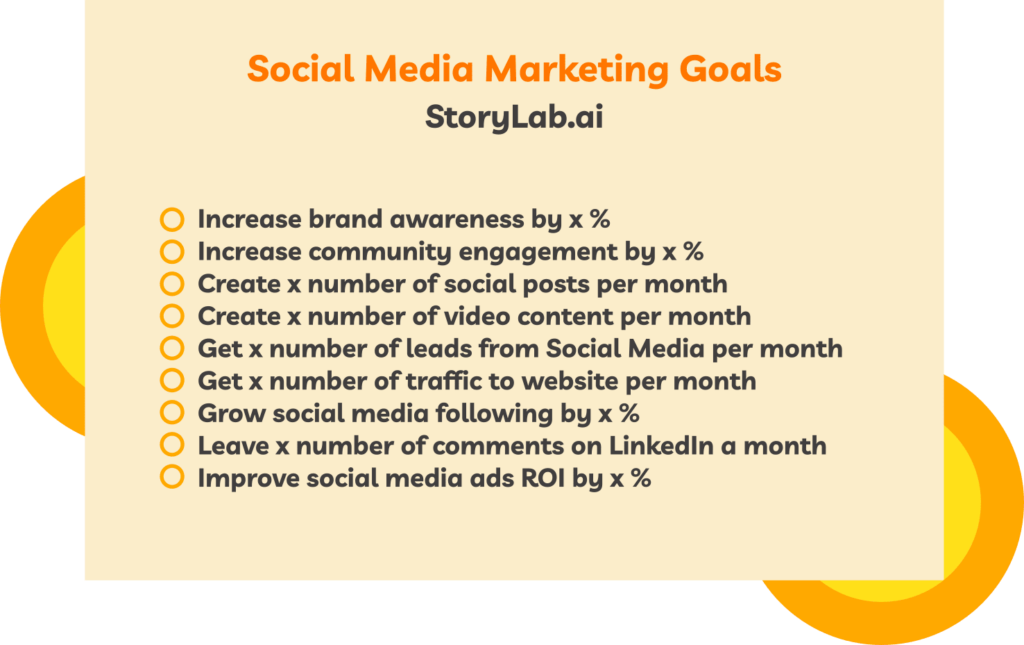
How to set the right goals for your Social Media Marketing Strategy?
To set the right goals for your strategy, think about the following:
- Look back, what can you learn from previous month / years?
- What is realistic to achieve this year?
- Will these new goals actually help my business or are they just vanity metrics?
- Have you communicated your new goals with colleagues and management? Do you have buy-in?
- Do you have a process in place to easily track your progress?
2. Think of your organic social messaging as a cyclic customer journey
As marketers, we have this wonderful false sense that the journey a customer takes to come to a decision to buy, follows some kind of more or less linear path that we can map out. We also know that the customer journey is just a model. As such, it can help.
- Map out what your customer is thinking, wondering, experiencing, and what she wants or needs through the phases we call Awareness, Acquisition, and Activation (or See, Think, Do). You do this by talking to your customer.
- Translate your brand message into (5) categories, pillars, or themes for your content that answers the questions your prospective buyers might have along these phases. Read more about this below.
- Create a cyclic customer journey with your content on social media and the order in which you push it out, for instance, weekly. Understand that you don’t know when which person who comes across your message on their social feed, is in what phase.
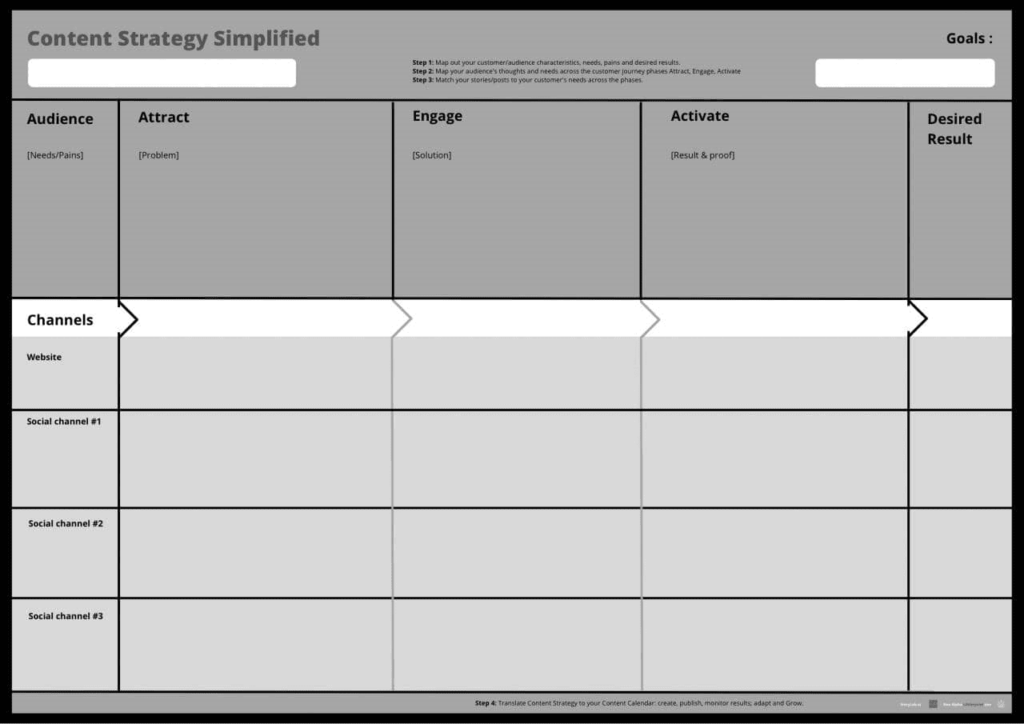
3. Define 5 content themes so you have guidelines on what to post and how it should look and sound.
Based on the needs you identified your prospective customer has along the See, Think, Do phases, consider splitting up your messaging aling the following five lines:
Problem and brand awareness
Talk about the problem your product or service solves, in the way that your ideal customer experiences it. Talk about your view on why it’s so important and urgent that it’s solved, and your view on how it should be approached.
Vision, sub-topics, how-to
Talk about (and curate) trends in your market, and talk about your vision for problems your customers are facing in three or so areas related to your overarching niche. For instance; if I’m offering content marketing services, one sub-topic I might want to talk about is content strategy; what problems people have with it, and how to solve it. See what I did, there?
Personality and trust
Show yourself; the personality and values of your brand and specifically the people involved in it. Show the people on your team and celebrate then for their expertise and personality. Do the same with your business partners and best customers: share the love.
Brand & product positioning, USPs, and proof:
Only in 1/5 posts, talk about your brand mission, your specific solutions or overarching offering, and your USPs. Add proof, by way of customer quotes and/or actual numbers and percentages of proven improvement in metrics that matter to your prospects.
Responsibility, ethics, and miscellaneous:
If you have a purpose for your business, show it. By showing how you think about how your work or your market can add to actually leaving the world better than you found it, and about what you do to put it into practice. This is the space for your CSR vision and initiatives, alternated by miscellaneous news about your company or industry.
4. Decide what content types you want to connect to your content themes, what channels you want to post on and what you want to emphasize on which channel.
Ideally, post about three times per week on LinkedIn and daily on Twitter.
After you’ve done your groundwork with the exercises presented in this article, the following two tools should help you scale content creation quite easily.
Create great Social Media Captions with StoryLab.ai’s Social Caption Generator
We’ve created our AI-Powered Social Media Caption Generator to help content creators to have a 24/7 buddy to spar with for gathering new social media post ideas and even complete social media post captions.
Simply describe our AI Buddy what your would like to post about and the AI will do the heavy lifting.
After you’ve created a list of potential captions, add your unique human touch and perfect them.
Here’s what it looks like:
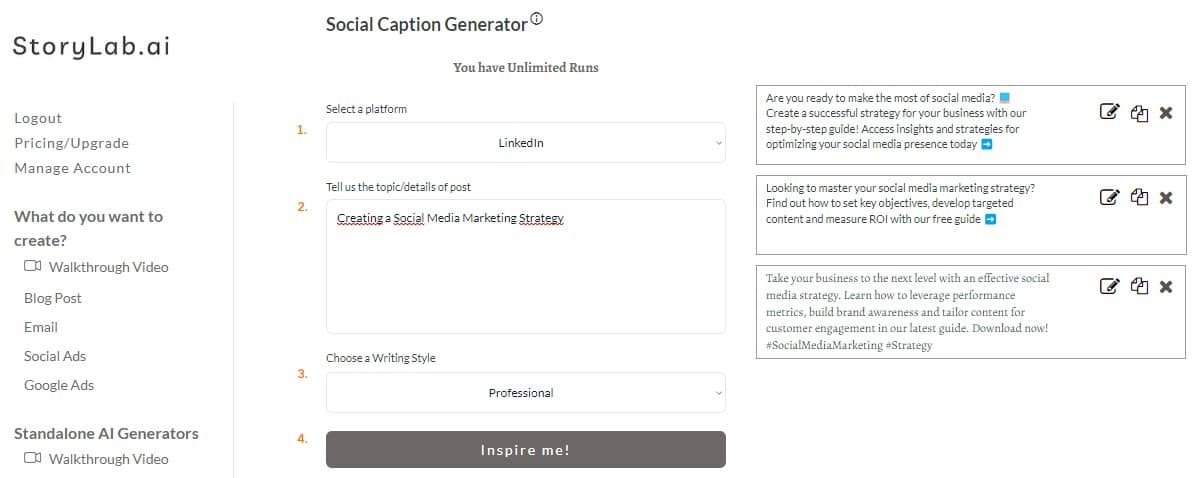
AI Tool for the Pros
If you really want to take it up a notch, check out the AI-Powered Blog to Social Media Post Generator. Simply copy/paste a piece of text from a blog post and get up to 25 different social media captions. This way, you can promote your content from different angles and really get people excited about your topic / content over a longer period of time.
Check out this short video to learn more:
Make sure 1 out of every 2 posts to have some kind of moving image like an animated element (you can get this easily and cheaply in tools like Canva).
Don’t forget to think about how to supplement and integrate your social media strategy with other channels such as SEO, SEA, email, and so forth.
Don’t forget to set up at least a basic structure for inviting your team members to boost your social media footprint by
- Liking and commenting on your posts and
- Much more importantly – sharing their own updates around your strategic content themes on their own platforms.
If you follow these steps, it becomes much easier to know what to post about, when and where to post and in what format – in order to help solidify your brand and boost commercial results across the board.
Hope this has been helpful in creating your Social Media Marketing Strategy.
Here’s a summary of what we’ve discussed in a short video format.
Now let’s have look at a couple of more tactical aspects of getting more out of your Social Media Marketing efforts.
Setting up your Social Media Distribution Strategy
After you’ve set up your overall Social Media Marketing strategy, it’s time to have a look at how you distribute content on social media. It often comes down to the following:
- Which social media channels do you want to be active on?
- How often do you want to post on each channel?
- Which content format do you want to post per channel?
It can look something like this:
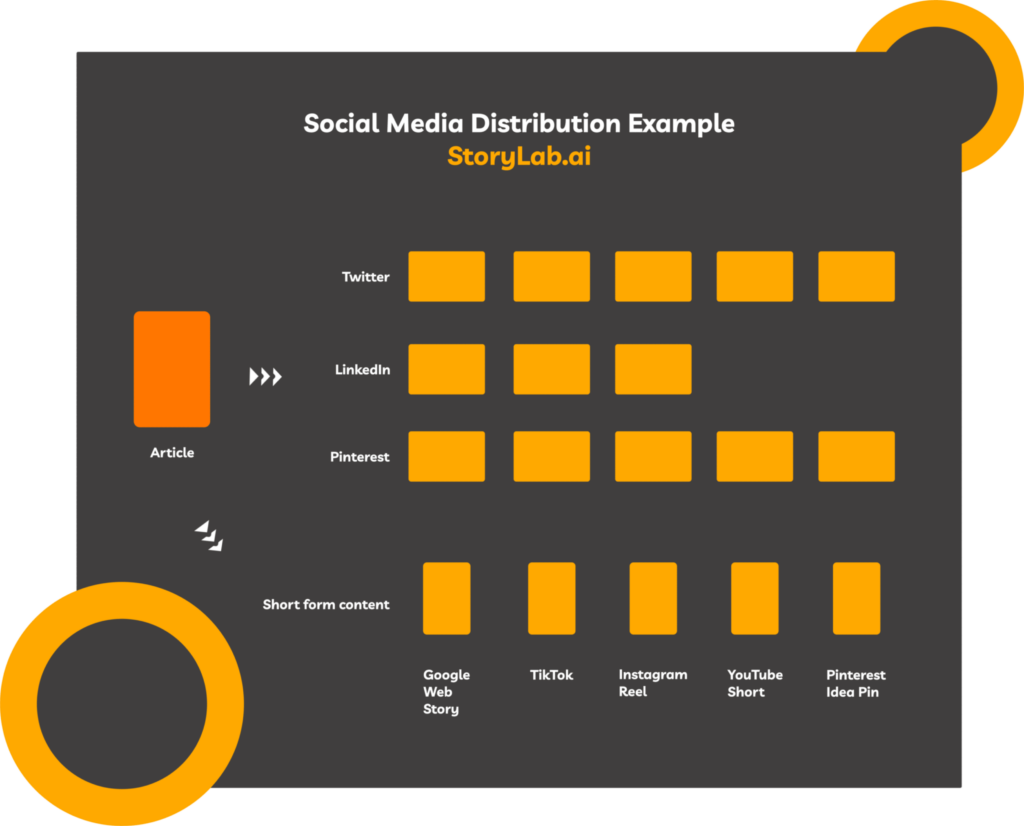
Here you can see that you want to take your ‘long-form content’ and create social posts for:
- Twitter;
- LinkedIn;
- Pinterest.
You also see that you want to create fewer posts for LinkedIn because you find that posting on Twitter and Pinterest a couple of times a day is fine, but maybe you don’t want to do that on LinkedIn.
You also see that you want to take that long-form content and create short-form content like:
- Google Web Stories;
- TikTok videos;
- Instagram Reels;
- YouTube video Shorts;
- Pinterest Idea pin.
This is a simple illustration of channel and format choices you can make for your social media distribution strategy. Head over to our free Content Distribution Sheet (no email signup is required) and fill in:
- On the Y-axis your long-form content (starting with your most important content)
- On the X-axis your social media channels (starting with your most important channels)
Here’s how it will look like:

Then, start to work on the sheet.
Start creating Social Media content for promoting your content and keep track of which posts your created for which content on which channels. By starting with your most important content and channels, you’ll see that the top left part of the sheet should be your priority and you should work your way down and to the right.
Here’s how that looks like:
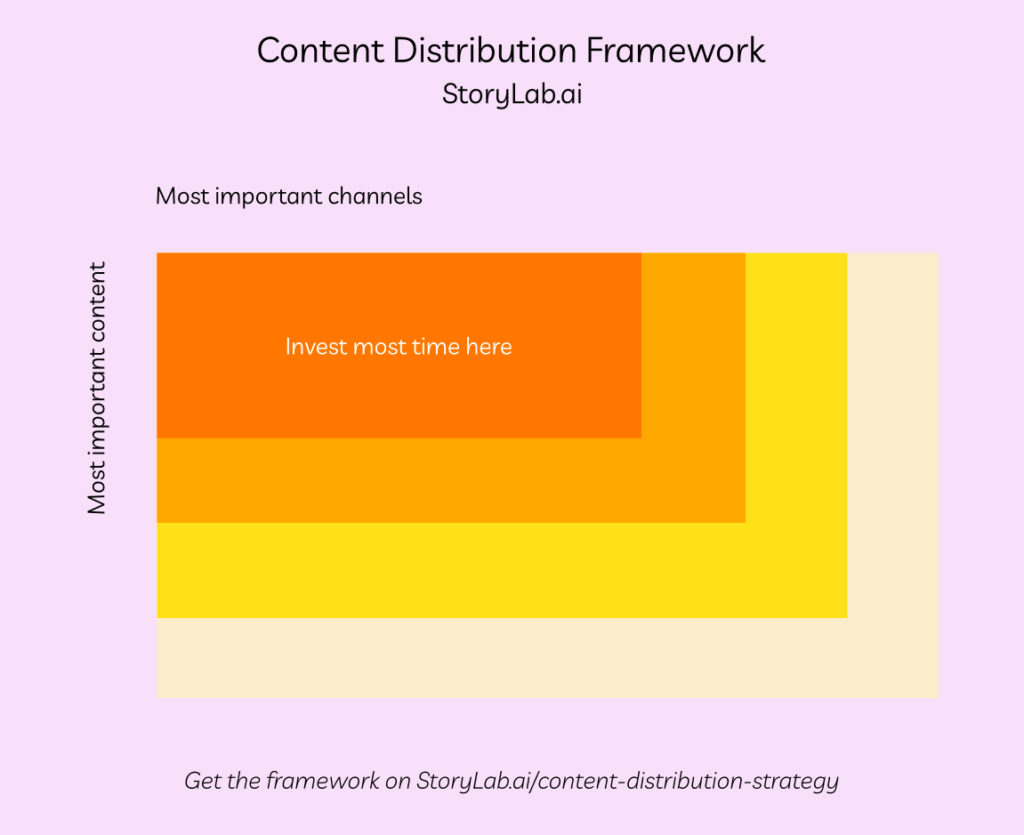
How to select the right Social Media Channels
So how do you select the social media channels that will help you to be most effective?
The most important thing is to understand the reason people are on a social media platform and if your audience is actually on that platform.
People go to:
- Pinterest to be inspired;
- YouTube to learn;
- TikTok to be entertained;
- Facebook to stay in touch with family and friends;
- LinkedIn to learn and connect;
- etc.
It will of course not hold true for everyone but in general, that’s how most people see social media platforms.
After you’ve found out if your audience is on a platform and you can create content that matches that platform, it’s time to see if it’s worth your time. You can decide if a social platform is worth your time investment by looking at historical data.
Have you been on Twitter for years, creating a ton of quality content but are you stuck in terms of impressions, followers, clicks to your website, etc.?
If so, check if you can create new content formats that the platform is pushing or maybe decide to increase your efforts on other platforms.
For instance. Your growth can be stale on Pinterest, Google, Instagram, and YouTube because you’ve been creating legacy content formats. If so, try creating:
- Pinterest Idea pins;
- Google Web Stories;
- Instagram Reels;
- YouTube Shorts.
Social Media Platforms often add new content formats to keep up with other platforms. While doing so, they need a lot of content in that format. If you’re a creator that can help out, you’re content will most likely be pushed to a larger audience than you’ve ever reached before.
So before giving up on a social platform, check if you’ve tried out all (especially new) formats. If you’re still not getting the results you expect (compared to other channels) then it might be time to invest less time.
Being active on Mainstream vs New Social Media Platforms
The next question is, how often / quickly should you jump on new social media platforms coming out and how much time should you keep investing in mainstream / traditional social media platforms like Facebook, Twitter, Instagram, Pinterest, LinkedIn, etc.?
Social media platforms come and go. Some faster than others and some stay but organic reach is decreasing year over year (Facebook for instance).
As we saw in our social media distribution section, there is a lot we can do but prioritizing is key.
There is no one answer I can give you. Like everything in marketing, it depends. Here are a couple of things to consider though:
Just getting started with fresh Social Media accounts:
- Create 3 mainstream social media accounts where your audience is active;
- Create content in new formats;
- Create 3 social media accounts on new up-and-coming platforms;
- You have your work cut out for you, don’t start with social platforms that are just getting off the ground.
Already have a strong presence on mainstream Social Media platforms:
- Keep going strong;
- Create content in new formats;
- Create 2 social media accounts on new up-and-coming platforms;
- Create 1 social media account on a platform you believe in but is just going mainstream.
I would always opt in for trying new social media channels. The question is of course how much time you invest in them.
Creating short-form content for Social Media
As you’ve seen earlier in the article, social media platforms are pushing hard for new short-form content formats. Not just video.
Google Web Stories and Pinterest Idea Pins do not need to be video.
Instagram Reels, YouTube Shorts, TikToks do need to be video.
People seem to love consuming short-form content. That’s the data these platforms are receiving and they want to provide. Because if YouTube does not provide, then TikTok will!
The question is, are you a social media manager that also wants to provide short-form content to your audience? If not, someone else will.
We use Canva Pro to create our YouTube shorts, Instagram Reels, and TikTok videos and Pinterest provides a simple way to create Idea Pins while Google offers an easy way to create Google Web Stories if you’re using WordPress.
The challenge is to tell your story in a short and catchy way but also to make your short-form content fit your overall social media marketing strategy.
Long-form content will not disappear. But short-form is where the attention is at the moment and where you can get the most impressions.
Be sure to implement it into your strategy.
FAQs
Should I create a Persona for my Social Media Strategy?
You can create a Persona for your social media strategy but be mindful that on social, you might want to interact with a larger community. It is always good to know who your Persona / Target Audience is to determine where they might hang out. On which social platforms you might be able to reach them best. Don’t only engage with your Persona. Especially not when someone outside of your Persona engages with you. Don’t think it’s not worth your time engaging because they’re not in your target audience.
Should I create an Ideal Customer Profile (ICP) for my Social Media Strategy?
We do not advise creating an Ideal Customer Profile (ICP) for your social media strategy. This might narrow your activities too much and deter you from engaging with a larger audience. An Ideal Customer Profile has its own place in an organization, but we would not advise spending time setting that up if you don’t already have it set up to improve your Social Media Marketing Strategy.
Should I do a Competitive Analysis for my Social Media Strategy?
It is always good to learn more about what works and what does not. For your Social Media Strategy, you can have a closer look at your competitors and see what you can learn from them. What types of posts are they creating, who is following them, who is engaging with them, etc? Don’t just look at your competitors. Take it one or several levels higher and look at what is working (and not working) in your niche / industry beyond your competitors.
What is Social Media Listening?
Social Media Listening is setting alerts to get notifications when someone mentions you, a competitor, or topic. You often get notified when someone tags you, but sometimes, people accidentally don’t tag you properly. It’s always good to set up Social Media Listening for variations of your Social Media Handle Name. You can also set up Social Media listening to get notified when someone talks about a competitor or topic you’re interested in. Usually, you need additional Social Media Tools to set up Social Listening.
How often do I need to do a Social Media Audit?
It’s good to do a Social Media Audit every quarter. At the end of the year, you can do a more in-depth social media audit to prepare for the year to come.
How to do a Social Media Audit?
When doing a Social Media Audit, you can look at the following aspects:
- What is and is not working for you (check the goals you’ve set)?
- Are you posting at the frequency you’ve set for yourself?
- What types of posts are doing well / not so well?
- Which social platforms are doing well / not so well at the moment?
- Who is engaging with you on which platforms?
- Which of your relationships are the most valuable can you invite them to collaborate on a different platform?
- How does the competition’s social media presence compare to yours?
What is a social media marketing strategy?
A social media marketing strategy is a plan of action to build a brand and increase its visibility through different social media platforms, focusing on content creation, audience engagement, and marketing goals.
Why is a social media marketing strategy important?
It’s essential for targeting the right audience, engaging with followers effectively, maximizing ROI from social platforms, and ensuring a consistent and effective brand message across different channels.
What are the key components of a successful social media marketing strategy?
Key components include understanding your target audience, setting clear objectives, choosing the right platforms, creating engaging content, regular posting, and analyzing performance metrics.
How do you measure the success of a social media marketing strategy?
Success can be measured using metrics such as engagement rates, follower growth, website traffic referred from social media, conversions, and overall ROI.
What role does content play in a social media marketing strategy?
Content is crucial as it attracts and engages the target audience, reflects the brand’s identity, and drives social interactions and conversions.
How often should a social media marketing strategy be updated?
It should be reviewed and updated regularly, ideally quarterly or bi-annually, to adapt to changing social media trends, audience preferences, and the brand’s evolving goals.
Can a social media marketing strategy improve customer service?
Yes, it can significantly improve customer service by providing platforms for quick responses, engaging with customers, and addressing their concerns publicly and efficiently.
What’s the importance of choosing the right social media platforms?
Different platforms cater to different demographics and content types. Choosing the right platform ensures you’re reaching your target audience effectively.
How can small businesses develop an effective social media marketing strategy?
Small businesses should focus on platforms where their audience is most active, use cost-effective content strategies like user-generated content, and leverage analytics to understand what works.
What is the role of influencers in a social media marketing strategy?
Influencers can extend the reach of your brand to their followers, provide authentic endorsements, and create content that resonates with a broader audience.
How does audience targeting impact a social media marketing strategy?
Effective audience targeting ensures that your marketing efforts reach the most relevant and interested users, increasing engagement and the likelihood of conversions.
What is the significance of a content calendar in social media marketing?
A content calendar helps in planning and organizing posts in advance, ensuring a consistent posting schedule and a balanced mix of content types aligned with strategic goals.
How do you integrate branding into a social media marketing strategy?
Branding can be integrated by consistently using brand colors, logos, and voice across all posts and interactions, reinforcing brand identity and recognition.
Can social listening tools enhance a social media marketing strategy?
Social listening tools track mentions, keywords, and sentiments about your brand, providing insights that can refine and improve your marketing strategy.
What role does video content play in social media marketing?
Video content is highly engaging and can significantly increase reach and engagement, making it a crucial component of contemporary social media strategies.
How important is engagement in a social media marketing strategy?
Engagement is critical as it builds relationships with the audience, fosters community, and increases the organic reach of your content through likes, comments, and shares.
Can user-generated content be part of a social media marketing strategy?
User-generated content is powerful for building community and trust, as it showcases real customers and their experiences, adding authenticity to your brand.
What is the impact of hashtags on a social media marketing strategy?
Hashtags increase the discoverability of your content on platforms like Twitter and Instagram, helping to target niche audiences and participate in relevant conversations.
How does a social media marketing strategy drive website traffic?
By sharing links to your website in your posts and bio, and creating compelling content that invites clicks, social media can be a significant driver of traffic to your site.
What is the importance of analytics in refining a social media marketing strategy?
Analytics provide data on what’s working and what’s not, allowing for data-driven adjustments to the strategy to improve engagement, reach, and effectiveness.
How does personalization enhance a social media marketing strategy?
Personalization, such as using audience data to tailor content, can significantly increase engagement and relevance, making the strategy more effective in attracting and retaining followers.
What role does community management play in social media marketing?
Community management involves interacting with followers, responding to comments, and fostering a community around your brand, which is vital for building loyal customer relationships.
How can collaborations with other brands or influencers benefit a social media strategy?
Collaborations can expand your reach to new audiences, bring fresh content to your platforms, and increase credibility through association with respected figures or brands.
What is the importance of consistency in social media marketing?
Consistency in posting frequency, content quality, and brand voice helps in building a reliable brand image, which is key to maintaining and growing a social media presence.
Can a social media marketing strategy drive offline engagement?
Yes, social media can be used to promote offline events or engagements, creating a seamless experience that encourages online followers to engage in real-world activities.
What’s the role of storytelling in a social media marketing strategy?
Effective storytelling can captivate audiences, evoke emotions, and build a stronger personal connection with the brand, enhancing the overall impact of the strategy.
How do promotional contests and giveaways fit into a social media strategy?
Contests and giveaways can quickly increase engagement and reach, encouraging user participation and spreading brand awareness through user shares and mentions.
How critical is the visual aesthetic of content in social media marketing?
A consistent and appealing visual aesthetic is crucial as it helps in establishing brand identity, making content instantly recognizable, and enhancing the visual appeal for the audience.
What is the impact of social media algorithms on marketing strategies?
Understanding social media algorithms is essential for optimizing content for better visibility and engagement, as these algorithms determine how and to whom the content is shown.
How can a social media strategy adapt to changing platform trends?
Staying informed about platform updates and changing user behaviors is key, allowing marketers to adjust their strategies to leverage new features and trends effectively.
Jump back to a section
- 1. Understand exactly why organic social media is important for you, and what goals you want to achieve with it.
- How to set the right goals for your Social Media Marketing Strategy?
- 2. Think of your organic social messaging as a cyclic customer journey
- 3. Define 5 content themes so you have guidelines on what to post and how it should look and sound.
- 4. Decide what content types you want to connect to your content themes, what channels you want to post on and what you want to emphasize on which channel.
- Setting up your Social Media Distribution Strategy
- How to select the right Social Media Channels
- Being active on Mainstream vs New Social Media Platforms
- Creating short-form content for Social Media
- FAQs
Author bio:
 Erwin Lima: What inspires Erwin is helping people, teams and brands to become the best version of themselves. Guiding them with curiosity, empathy, and Growth Storytelling.
Erwin Lima: What inspires Erwin is helping people, teams and brands to become the best version of themselves. Guiding them with curiosity, empathy, and Growth Storytelling.
Over the past 10+ years as a copywriter, author, consultant, and coach, he’s helped dozens of Brands, Teams, and individual human beings to grow their sense of motivation and focus, but also their reach, engagement, and revenue— through the power of their own story. You can find Erwin on LinkedIn and on his website.
Author bio:
 Raul Tiru: Raul loves to build companies and help startups and scale-ups grow. Raul started his first website when he was 17 years old, has held several growth marketing positions in fast-growing companies, and has helped companies via his Freelance Marketing services. You can find Raul on his community GlobalOwls where he helps Nonprofits and Startups to do better marketing.
Raul Tiru: Raul loves to build companies and help startups and scale-ups grow. Raul started his first website when he was 17 years old, has held several growth marketing positions in fast-growing companies, and has helped companies via his Freelance Marketing services. You can find Raul on his community GlobalOwls where he helps Nonprofits and Startups to do better marketing.
Master the Art of Video Marketing
AI-Powered Tools to Ideate, Optimize, and Amplify!
- Spark Creativity: Unleash the most effective video ideas, scripts, and engaging hooks with our AI Generators.
- Optimize Instantly: Elevate your YouTube presence by optimizing video Titles, Descriptions, and Tags in seconds.
- Amplify Your Reach: Effortlessly craft social media, email, and ad copy to maximize your video’s impact.